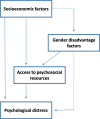Prevalence and correlates of psychological distress among 13-14 year old adolescent girls in North Karnataka, South India: a cross-sectional study
- PMID: 30630455
- PMCID: PMC6327490
- DOI: 10.1186/s12889-018-6355-z
Prevalence and correlates of psychological distress among 13-14 year old adolescent girls in North Karnataka, South India: a cross-sectional study
Abstract
Background: Mental health disorders among adolescents have emerged as a major public health issue in many low and middle-income countries, including India. There is a paucity of research on the determinants of psychological distress, particularly among the poorest girls in the poorest communities. The purpose of this study was to assess the prevalence and correlates of different indicators of psychological distress among 13-14 year old low caste girls in rural, south India.
Methods: Cross-sectional survey of 1191 low caste girls in two districts in north Karnataka, conducted as part of a cluster randomised-control trial. Bivariate and multivariate logistic regression analysis assessed correlates of different indicators of psychological distress.
Results: More than one third of girls (35.1%) reported having no hope for the future. 6.9% reported feeling down, depressed or hopeless in the past 2 weeks. 2.1% reported thinking they would be better off dead or of hurting themselves in some way in the past 2 weeks. 1.6% reported sexual abuse, 8.0% rrecent eve teasing and 6.3% having no parental emotional support. Suicidal ideation was independently associated with sexual abuse (AOR 11.9 (3.0-47.0)) and a lack of parental emotional support (AOR 0.2 (0.1-0.5)). Feeling down, depressed or hopeless was independently associated with recent eve-teasing (AOR 2.9 (1.6-5.4)), a harassing or abusive school environment (AOR 3.9 (1.8-8.2)), being frequently absent (AOR 2.8 (1.5-5.5)) or having dropped out of school (AOR 2.1 (1.0-4.3)), and living in Vijayapura district (AOR 2.5 (1.6-4.1)). Having no hope for the future was independently associated with a range of factors, including recent "eve-teasing" (AOR 1.5 (1.0-2.4)), being engaged (AOR 2.9 (0.9-9.7)), not participating in groups (AOR 0.5 (0.4-0.6)) and a lack of emotional support (AOR 0.6 (0.4-0.7)).
Conclusions: Rather than being a time of optimism, a third of low caste girls in rural north, Karnataka have limited hope for the future, with some contemplating suicide. As well as having important development benefits, interventions that address the upstream structural and gender-norms based determinants of poor mental health, and provide adolescent services for girls who require treatment and support, should have important benefits for girls' psychological wellbeing.
Trial registration: Prospectively registered at ClinicalTrials.GovNCT01996241 . November 27, 2013.
Keywords: Adolescent girls; Child marriage; Psychological distress; School drop out; Sexual abuse; Suicide ideation.
Conflict of interest statement
Ethics approval and consent to participate
The Samata project evaluation was approved by institutional review boards at St. Johns Medical College and Hospital, Bangalore, India (111/2013), The London School of Hygiene & Tropical Medicine, UK (7083), and The University of Manitoba, Canada (H2014:414). Parents/legal guardians/spouses of all eligible girls were approached and asked for their witnessed written informed consent. Witnessed written informed assent was independently obtained from participants considered to be minors (anyone under the age of 18 years).
Consent for publication
Not Applicable.
Competing interests
The authors declare that they have no competing interests.
Publisher’s Note
Springer Nature remains neutral with regard to jurisdictional claims in published maps and institutional affiliations.
Figures
References
-
- United Nations Population Fund . The power of 1.8 billion adolescents, youth and the transformation of the future. New York: UNFPA State of World Population; 2014.
Publication types
MeSH terms
Associated data
LinkOut - more resources
Full Text Sources
Medical
Research Materials
Miscellaneous


